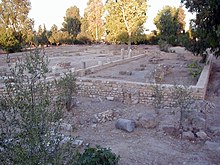Archdiocese of Carthage Archidioecesis Carthaginensis | |
|---|---|
| Bishopric | |
 Early Christian quarter in ancient Carthage | |
| Incumbent: Cyriacus of Carthage (last residing ca. 1070) Agostino Casaroli (last titular archbishop 1979) | |
| Location | |
| Country | Roman Empire Vandal Kingdom Byzantine Empire Umayyad Caliphate Abbasid Caliphate Fatimid Caliphate French protectorate of Tunisia Tunisia |
| Ecclesiastical province | Early African church |
| Metropolitan | Carthage |
| Headquarters | Carthage |
| Coordinates | 36°51′10″N 10°19′24″E / 36.8528°N 10.3233°E) |
| Information | |
| Denomination | Catholic Church |
| Sui iuris church | Latin Church |
| Rite | African Rite |
| Established | 2nd century |
| Dissolved | In partibus infidelium in 1519 |
| Leadership | |
| Pope | Francis |
| Titular archbishop | Vacant since 1979 |
The Archdiocese of Carthage, also known as the Church of Carthage, was a Latin Catholic diocese established in Carthage, Roman Empire, in the 2nd century. Agrippin was the first named bishop, around 230 AD. The temporal importance of the city of Carthage in the Roman Empire had previously been restored by Julius Caesar and Augustus. When Christianity became firmly established around the Roman province of Africa Proconsulare, Carthage became its natural ecclesiastical seat.[1] Carthage subsequently exercised informal primacy as an archdiocese, being the most important center of Christianity in the whole of Roman Africa, corresponding to most of today's Mediterranean coast and inland of Northern Africa. As such, it enjoyed honorary title of patriarch as well as primate of Africa: Pope Leo I confirmed the primacy of the bishop of Carthage in 446: "Indeed, after the Roman Bishop, the leading Bishop and metropolitan for all Africa is the Bishop of Carthage."[2][3][4]
The Church of Carthage thus was to the Early African church what the Church of Rome was to the Catholic Church in Italy.[5] The archdiocese used the African Rite, a variant of the Western liturgical rites in Latin language, possibly a local use of the primitive Roman Rite. Famous figures include Saint Perpetua, Saint Felicitas, and their Companions (died c. 203), Tertullian (c. 155–240), Cyprian (c. 200–258), Caecilianus (floruit 311), Saint Aurelius (died 429), and Eugenius of Carthage (died 505). Tertullian and Cyprian are both considered Latin Church Fathers of the Latin Church. Tertullian, a theologian of part Berber descent, was instrumental in the development of trinitarian theology, and was the first to apply Latin language extensively in his theological writings. As such, Tertullian has been called "the father of Latin Christianity"[6][7] and "the founder of Western theology."[8] Carthage remained an important center of Christianity, hosting several councils of Carthage.
In the 6th century, turbulent controversies in teachings affected the diocese: Donatism, Arianism, Manichaeism, and Pelagianism. Some proponents established their own parallel hierarchies.
The city of Carthage fell to the Muslim conquest of the Maghreb with the Battle of Carthage (698). The episcopal see remained but Christianity declined under persecution. The last resident bishop, Cyriacus of Carthage, was documented in 1076.
In 1518, the Archdiocese of Carthage was revived as a Catholic titular see. It was briefly restored as a residential episcopal see 1884–1964, after which it was supplanted by the Roman Catholic Archdiocese of Tunis. The last titular archbishop, Agostino Casaroli, remained in office until 1979. Subsequent to this, the titular see has remained vacant.
- ^ Bunson, Matthew (2002). "Carthage". Encyclopedia of the Roman Empire. Facts on File library of world history (Rev. ed.). New York: Facts On File. pp. 97–98. ISBN 9781438110271.
- ^ Herbermann, Charles, ed. "Africa". Catholic Encyclopedia. (New York: Robert Appleton Company, 1913).
- ^ François Decret, Early Christianity in North Africa (James Clarke & Co, 25 Dec. 2014) p86.
- ^ Leo the Great, Letters89.
- ^ Plummer, Alfred (1887). The Church of the Early Fathers: External History. Longmans, Green and Company. pp. 109.
church of africa carthage.
- ^ Benham, William (1887). The Dictionary of Religion. Cassell. pp. 1013.
- ^ Ekonomou 2007, p. 22.
- ^ Gonzáles, Justo L. (2010). "The Early Church to the Dawn of the Reformation". The Story of Christianity. Vol. 1. New York: HarperCollins Publishers. pp. 91–93.